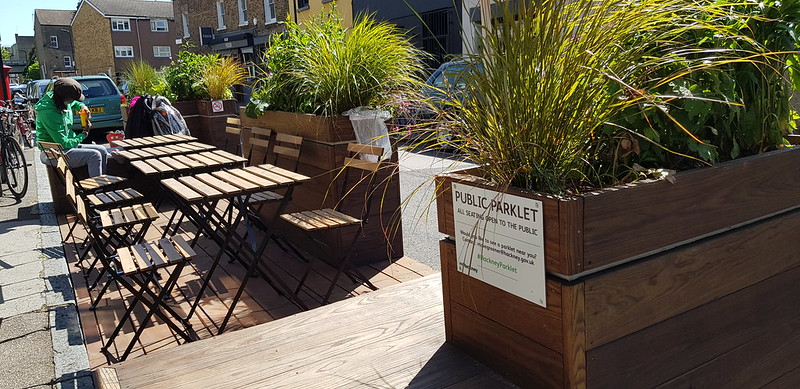Parklets
We have committed to reducing the dominance of cars on our roads in our transport strategy. Approximately 70% of our residents don’t own a vehicle, yet the kerbside remains dominated by parking. Our valuable kerbside space could instead be used for something to improve the urban realm for all, rather than simply using it for car storage.
Parklets are a means of repurposing a parking space on the street where you live, or near a business premises, for public use rather than for the parking of cars. Existing parklets in Hackney include amenities such as planters, cycle parking, greenery, public seating.
Do you want a parklet of your own?
We’re supporting residents with the opportunity to provide new community parklets in the borough. These will be delivered by the council in collaboration with residents and local community groups.
If you become a Parklet Keeper, you will be responsible for the:
- design of the scheme
- cost for construction and installation of the structure
- upkeep and maintenance of your parklet
We review submissions to make sure suggested locations are suitable.
Applications must meet eligibility and design criteria.
Parklet locations should be well-placed, safe to use on the carriageway (the part of the road for vehicles) and offer the greatest benefit to the people who may use them.
We will approve up to 3 community or resident parklet applications in 2025.
Application process stage 1: initial parklet proposal
The parklet programme is available to Hackney residents and community groups.
1. Register your interest
You can let us know if you’re interested in owning a Parklet at any time, as expressions of interest are open all year.
However, we only accept applications once a year, during the spring, with this year’s application window starting in April 2025.
We’ll send the details to everyone who has shown interest.
2. Read the parklet design guidance
3. Discuss with your neighbours and get their support
Speak to as many people as possible who live near the proposed site and include those on the opposite side of the street. Tell them what you are planning.
The more support you get, the greater the chance of your proposal going forward. You will be required to provide evidence of this in your Stage 2 application.
- community parklets letter of support template (PDF 245kb)
- community parklets letter of support template (Word 18kb)
4. Complete your Stage 1 application
When the application window opens, we will be in touch with you to confirm your intent to apply for a parklet and will provide you with the Stage 1 application form.
We will evaluate proposals to see if they are workable in principle and where the location is suitable at a fundamental level (for example, not representing a safety hazard) If you are successful at this first stage you will be invited to produce a more detailed Stage 2 application.
If your Stage 1 proposal is rejected, we will provide feedback on why it was not suitable. You will have the opportunity to re-apply again using the Stage 1 application form.
Application process stage 2: detailed parklet proposal
1. Maintenance plan
A maintenance plan must be provided which sets out any regular maintenance that must be undertaken on your parklet for it to remain fully functional. This should include:
- general maintenance and repairs (i.e. to fixed items and furniture)
- plant maintenance
- cleaning
2. Finance plan
You will need to provide evidence that you can afford the maintenance costs for your parklet, to ensure its upkeep.
You should therefore seek cost estimates for parklet maintenance and set these out on an annual basis.
3. Evidence of local support
You will need to provide the full evidence of local support, which you will have started collecting during your Stage 1 application. This will ensure a smoother statutory consultation period following submission of your Stage 2 application.
4. Road safety audit
A road safety audit is a requirement for your parklet proposal, as it will identify any potential road safety issues. Road safety audits will be organised by Council officers, and they will provide you with details of this during the early stages of your Stage 2 application.
The audit will take into consideration the following matters:
- road layout and markings
- position of signs
- lighting provision
- construction and dimensions of the parklet
5. Traffic Management Order
The last stage of your Stage 2 application will involve the Council posting notice of a Traffic Management Order – a statutory requirement when changes are made to the highway and which involves a public consultation period.
As with all public consultations, it is possible that your proposal will receive objections. While we do not wish for this to be the case, if the Council receives a high number of objections it will be difficult to deliver your proposal and may ultimately lead to your parklet application being rejected.
However, by ensuring your proposal meets the guidance set out above and by providing us with a community letter of support, you stand the best chance of your proposal passing the consultation successfully.
This step will be undertaken by Council officers and will not require any further input from the parklet applicant.
6. Final approval
If you are successful with all of the previous steps, your application will be approved by council officers and you will be asked to enter into a parklet keeper agreement with the council.
Parklet Keepers are responsible for the general upkeep and maintenance of the Parklet on a day-to-day basis and throughout its life, in agreement with the council.
Once your agreement has been signed you will be able to start installing your parklet.
